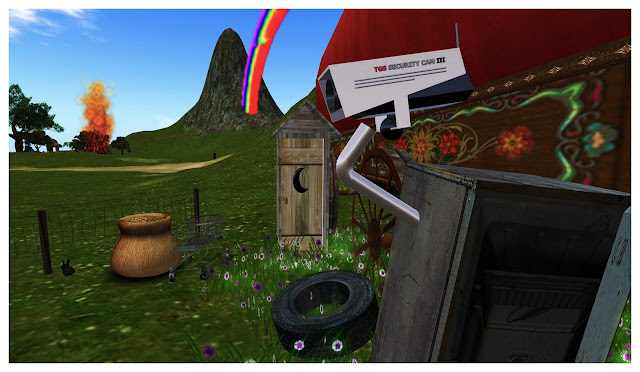Recently I was given a gift from Bryn Oh - a copy of the shopping trolley that she created for her "Anna's Many Murders" installation.
 |
| (click images to enlarge) |
I am very grateful and honoured.
I hold Bryn's work in the highest esteem.
I think you will agree, the shopping trolley looks just perfect between the latrine and the sack of dung.I had originally planned to write a long treatise on the philosophy of art - a "What Is Art?" type of article using Bryn's trolley as the central object of focus.
This article would have discussed the nature of art itself and how certain artists have taken everyday items and presented them as art, with Andy Warhol's 'Campbell's Soup Cans' being one of the most well known examples.
I thought it might be interesting to consider what makes Bryn's shopping trolley a "work of art" - is it the prim? the sculpty map? the union of prim and map maybe?
I would have considered the possibility that the shopping trolley in and of itself is not a "work of art" at all but merely one of a number of components which work together to finally form the artistic installation known as "Anna's Many Murders".
But for completeness sake, it certainly would have been necessary to consider the shopping trolley as a "work of art" in its own right, and further, ponder if we should not then similarly consider *any* textured prim as a "work of art".
If not, why not?
If I right-click 'edit' the shopping trolley, I see the Creator is listed as "Bryn Oh" and the Owner "Pixie Rain".
But what if I linked a new root prim created by myself to it? "Pixie Rain" would then be shown as both the Creator and Owner.
Have I just forged a piece of art?
Or have I created something entirely new - a "Genuine Pixie Rain" so to speak, irrespective of any "artistic" claims or merit, or indeed any "history" that may be inherent within the prim, the XML or the asset server database.
What would be the legal and moral implications of such an act?
It certainly would have been interesting to examine what we mean by the phrase "3D Artist".
Surely most any work in most any medium is "3D", ie: having length, width and depth.
Why do we apply the term to those working in artistic software generally and virtual worlds particularly?
All these are interesting and valid questions.
The answers to these questions may provide some insight to the future evolution of software-based art but, after due consideration, I decided to leave these lofty matters to others and simply present these pictures to you, and thank Bryn Oh sincerely for her generosity and kindness.
Pixie
xxx












No comments:
Post a Comment